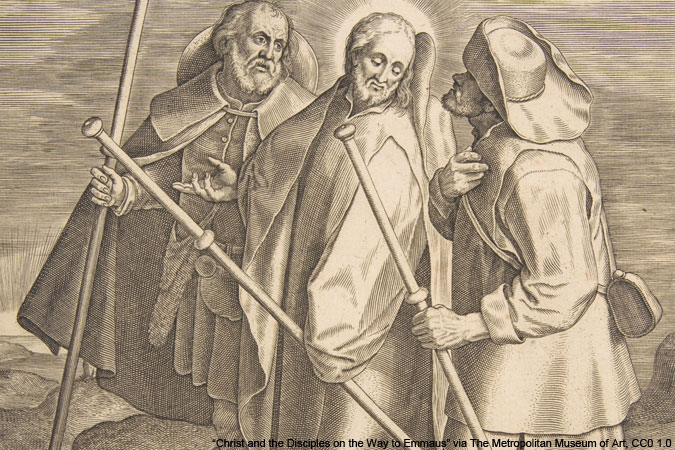
The downside of having a late Easter this year is that we only have one full session after returning from Easter break and before our May Crowning closes the year. This means that I have to condense my Easter Season lessons from two or three to one. Here’s my basic plan.
I’ll start by playing a recording of Handel’s “Hallelujah Chorus.” While this song is more often played during Christmastime, the celebratory “Hallelujahs” make it an appropriate anthem to set up an Easter session. And since we started our Lenten sessions with moments of silence, the vibrant change of pace should be an attention-grabber.
Then we’ll explore a variety of post-Resurrection appearances, up to and including the Ascension. Normally I reserve the Ascension for another session, but this year we’ll have to do a quicker tour of the times Christ appeared to the disciples after the Resurrection. One story we’ll pause to explore in more detail is the Emmaus story. Using two special features, we’ll look at an art print from Finding God, Grade 7, Session 21, which features Dinah Roe Kendall’s Road to Emmaus, and we’ll listen to a recorded Scripture story of Luke 24:13–35.
My hope for this session is that the young people understand that the story continues after the Resurrection of Christ. Perhaps this condensed Easter lesson may be a blessing in disguise. I will take my students on a fast-paced tour of stories normally covered in several textbook chapters, and the effect hopefully will be to convey that the Apostles were still busy learning from Jesus in the time he spent with them between the Resurrection and the Ascension. They were busy getting ready to receive the Holy Spirit at Pentecost, and through their work as the early Church—work which continues today through all of us—the story continues.
During the final meeting of the year, I expect to cover the Pentecost story as a sending forth for the young people. For now, I’ll leave them staring up at the sky after the Ascension, wondering with the Apostles, “What’s next?”
How do you teach the wonder of Easter to your class? Which post-Resurrection accounts do your students most like learning about?
Image: “Christ and the Disciples on the Way to Emmaus” after Pieter Bruegel the Elder, by Philips Galle via The Metropolitan Museum of Art is licensed under CC0 1.0.



Hi Denise,
A theme we focus on in the Easter/Ascension/Pentecost lessons with the 6th graders is what it means to be a “witness” for Jesus. We read the short Scripture passages from Luke 24: Thus it is written that the Messiah would suffer and rise from the dead…You are witnesses of these things.” and from Acts 1: “You will be my witnesses…to the ends of the earth.” We ask the youth to describe what a “witness” does in general terms, and then we discussed what the disciples did to “witness” to others about the Resurrection and the mission Jesus gave them before His Ascension.
I also like to use music clips or videos. I showed the youth the YouTube video “We Are Catholic” and we discussed what they think Jesus wants them to do to be His witnesses. Since this was our next to last class for the year, I had the youth write down hypothetical “Tweet” messages that they would send to other youth telling them something about God’s message to us that we learned this year in reading the Salvation Story in the Bible.
In hindsight, I would have liked to incorporate the message that was prominently displayed in banners in our Church Narthex and on the Church grounds: “Easter Changes Everything!” Maybe for next year!
Mary, thanks for sharing your lesson ideas. “Easter Changes Everything!” sounds like a great theme for a class next year, especially if it ties in with a broader parish message.
I need something like this for Advent/Christmas. Midwestern weather allowed only two weeks of religious education in December last year and one of them was the Feast of the Immaculate Conception so we went to Mass as a class. I didn’t cover Advent or Christmas very well and the Feast of the Holy Family or the Epiphany with my learners at all.
Julie, the December calendar often makes it a challenge to work on Advent and Christmas topics with our students, but I think the first step is to embrace that we may not be able to cover these seasons in-depth—and that’s ok! Part of the idea of continuous faith formation is that we build on understanding from year to year. I usually have two December sessions with my young people, and I like to devote one to Advent and do a Christmas project day for the other. I also try to introduce the season of Advent before Thanksgiving break, as usually the season starts during that week off from classes. That gives a few touch points for introducing the seasons. Remember, too, that the Christmas season lasts beyond December 25, so the first class back in January gives a good opportunity for continuing the celebration and the learning.